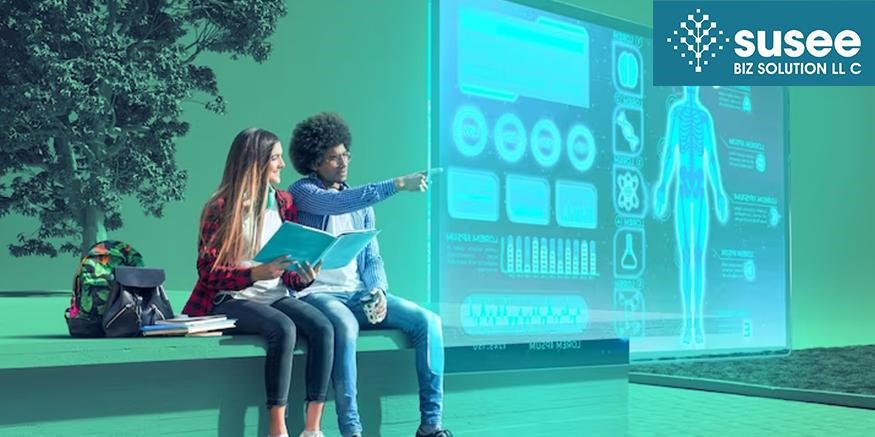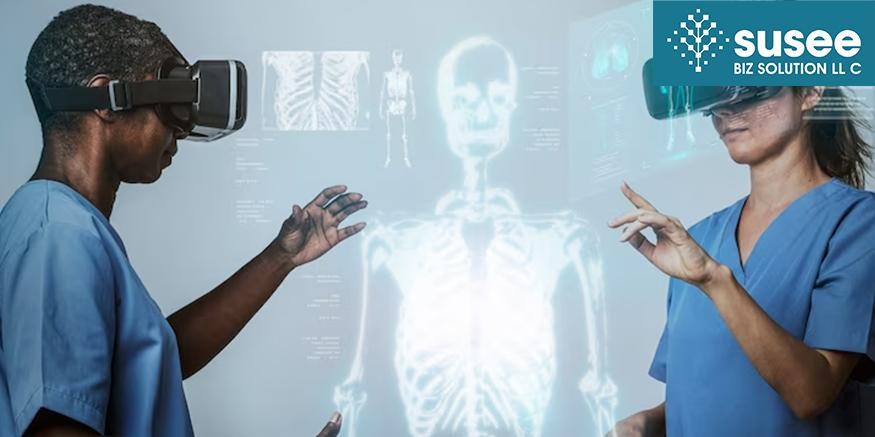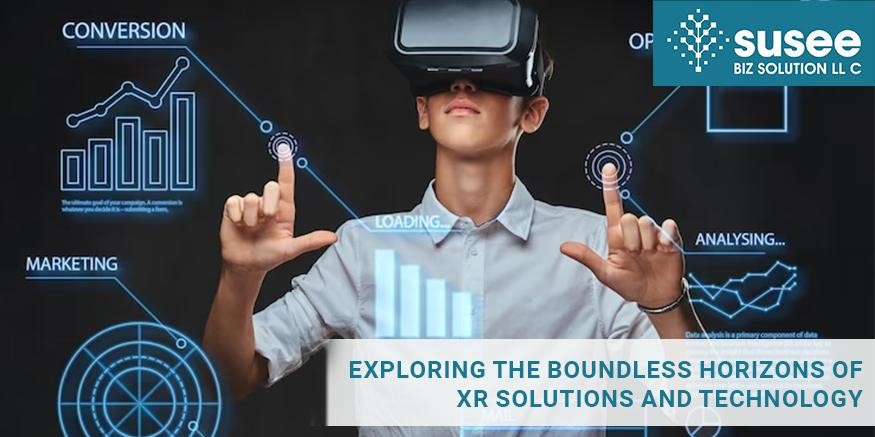Extended Reality (XR) is an emerging technological field in which physical and digital realms collide to produce engaging experiences once thought reserved only for science fiction novels. XR includes three main subsets: Virtual Reality (VR), Augmented Reality (AR) and Mixed Reality (MR), each providing its distinctive blend of real and virtual environments.
Overview of XR (Extended Reality)
Extended Reality technology offers three virtual and augmented realities to immerse its users completely within virtual spaces, distancing them from physical realities. Augmented Reality superimposes digital elements onto real environments to enrich perception with contextual data, while Mixed Reality goes one step further by seamlessly incorporating digital content into our surroundings for interaction purposes.
XR technology relies on an intricate mix of powerful hardware, sensors and sophisticated software. VR headsets, AR glasses and MR headsets are among the key tools for transporting users into these alternate realities, providing incredible depth and realism of experience – creating new dimensions of interaction along the way!
Significance and Impact
XR solutions‘ significance lies in their transformative power across numerous fields. Education students can use VR labs for virtual field trips and experiments safely, or healthcare surgeons can practice procedures before touching patients–XR is revolutionizing industries all across the board.
Extended Reality goes beyond entertainment: It provides problem-solving, training and innovation solutions. From architects imagining their designs on a human scale before breaking ground to retailers offering AR try-on services and remote workers collaborating in virtual offices, XR can bridge gaps and open doors of new opportunities.

The Evolution of XR: From Science Fiction to XR Solutions
XR represents our collective desire to transcend Reality by immersing ourselves in digital environments. Since its introduction, Extended Reality has quickly evolved from a mere futuristic dream into an industry-transforming force.
Historical Milestones in XR Development
The roots of Extended Reality can be traced back to the mid-20th century when virtual Reality first made an impactful debut. Filmmaker Morton Heilig developed the “Sensorama“, a contraption offering multisensory cinematic experiences in 1950; by 1970, computer scientist Ivan Sutherland designed one of the earliest head-mounted displays known as Sword of Damocles which established an early concept of virtual Reality that eventually led to what has come to be known as Extended Reality today.
The 1990s witnessed the introduction of consumer-grade virtual reality devices like Nintendo’s Virtual Boy; however, XR did not begin gaining serious traction until 2012, with Oculus Rift being released and marking a significant turning point. Later, AR became part of our everyday lives, with smartphones like the Pokemon Go app being widely adopted and AR being utilized within video games such as Skyrim – both phenomena demonstrated through VR/AR experiences that now play out daily!
Technological Advancements
Progression in hardware and software innovation has been essential to driving forward XR solutions. More affordable yet high-quality VR headsets like the Oculus Quest series have opened access to immersive experiences at cheaper costs. Meanwhile, tech giants Apple and Google invest heavily in AR initiatives like ARKit and ARCore, allowing mobile AR applications.
XR solutions have seen innovations in gesture tracking, haptic feedback and spatial mapping that enhance immersion realism and interactivity of experiences. Furthermore, AI integration has furthered this development of immersive VR experiences.
Applications of XR: Transforming Education through Immersive Experiences

Extended Reality (XR) is ushering in a new era of education by dismantling traditional classroom walls and revolutionizing how students access knowledge. From higher education institutions to primary schools, XR’s presence can be felt across educational landscapes – not least its impressive footprint within education.
XR in Higher Education
Virtual Reality (VR) enables college and university students to enter immersive environments for study subjects that come alive – through history lessons by exploring ancient civilizations on foot, molecular structure experiments close up or any other means with its ability to foster deeper comprehension and engagement while rendering complex topics more easily approachable. XR technology makes complex issues accessible.
Virtual Labs and Field Trips
Virtual labs and field trips are one of the standout applications of XR in higher education, thanks to its technologies allowing science, engineering, and medical program students to conduct experiments safely without using expensive equipment and risk. Furthermore, virtual field trips use XR technologies to transport students safely to distant locations like historical sites or outer space to broaden horizons beyond classroom walls.
Language Learning
Virtual reality technology has greatly assisted with language acquisition. Language learners can immerse themselves in virtual environments where authentic target language is spoken, converse with virtual characters, practice conversational skills and receive immediate feedback on progress made.
Collaborative Learning
Virtual Reality (XR) adds another level to collaborative learning, connecting students and educators no matter where they reside in virtual spaces. XR promotes teamwork, problem-solving, and creative thought processes as students collaborate on projects or explore simulations or virtual lectures together – increasing engagement while making learning an immersive social experience.
XR in Lower Education
Extended Reality (XR) has an impressive influence in lower education as it transforms higher and lower schools by offering immersive and inclusive learning opportunities to all levels. Through interactive storytelling, skill development, and inclusive education, XR solutions enrich classroom experiences for our youngest learners.
Interactive Storytelling
Interactive storytelling through XR is revolutionizing how young children engage with narratives. Traditional methods, like reading from books, have given way to interactive adventures where students step inside stories to interact with characters and explore plot settings, creating an enjoyable reading experience as they do so! XR also encourages children to embark on virtual adventures alongside beloved characters – turning learning into an unforgettable adventure experience!
Skill Development
XR provides an effective platform for skill development in lower education. Students can acquire all kinds of abilities – from problem-solving to spatial awareness – using interactive XR applications. Math concepts come alive as students solve real-life equations in captivating virtual environments. Such experiences not only make learning enjoyable but also strengthen essential abilities.
Inclusive Education
Inclusive education is at the core of modern pedagogy, and virtual reality solutions are pivotal in making it possible. By accommodating diverse student needs and learning styles – such as real-time captioning or sign language interpretation for those with hearing impairments – and offering alternative ways of experiencing educational content, virtual reality solutions enable educational institutions to ensure every child thrives within their classroom setting.
XR’s Impact Across Industries

Extended Reality has transcended its roots in gaming and entertainment, and they’re now reshaping industries in transformative ways. Let’s explore how XR is making its mark in manufacturing and industrial training, architecture and design, retail and marketing, and aerospace and automotive sectors.
Manufacturing and Industrial Training
Manufacturing and industry are among the industries’ most promising users for Virtual Reality training solutions since traditional approaches often entail costly physical setups that take too much time and cost to implement effectively.
VR allows employees to undergo immersive simulations that simulate real-world scenarios risk-free without leaving an employee unprepared. From assembly line procedures to equipment maintenance tasks, this immersive technology ensures employees are well prepared, cutting errors and downtime drastically.
Architecture and Design
XR technology has revolutionized the architecture and design industries alike. Architects can use immersive 3D models of buildings or products created in virtual spaces for clients and stakeholders to experience. This interactive approach enhances communication and understanding while permitting design refinements early. XR also helps simulate real world lighting conditions to provide a comprehensive view of final products.
Retail and Marketing
Businesses and marketers are turning to virtual and augmented reality technologies to enhance customer experiences. AR applications enable shoppers to visualize products before purchasing in their environments before making an uncertain decision, increasing confidence. AR marketing campaigns engage audiences through novel forms, providing immersive brand experiences. Furthermore, this tech is driving both in-store and online sales, which has the power to change the retail landscape.
Aerospace and Automotive
XR solutions are critical for designing, manufacturing and maintenance in the aerospace and automotive industries. Engineers utilize virtual reality software to simulate flight operations, test prototypes, train pilots and mechanics, and streamline design iterations while decreasing costs and improving safety; during maintenance services, technicians utilize real-time data with visual aids, providing efficient repairs.
XR Solutions Transforming Healthcare: Training, Recovery, and Remote Care

Extended Reality (XR) solutions are revolutionizing not just our daily life or work processes but are dramatically affecting healthcare as well. Within that industry alone, extended reality solutions are revolutionizing medical training, rehabilitation therapy, telemedicine, facility design, and even care delivery systems.
Medical Training and Simulation
One of XR’s most promising healthcare applications is medical training and simulation. By creating an immersive yet safe training environment for medical students and practitioners to practice surgical procedures, diagnose patients, and hone their skills – these simulations reflect real-life medical settings more realistically – using XR for training will enhance proficiency and patient care overall.
Rehabilitation and Therapy
XR has also proven itself an invaluable aid for rehabilitation and therapy, offering patients recovering from injuries or surgeries the chance to engage in fun yet motivating exercises using virtual environments tailored specifically towards therapeutic goals – making the rehabilitation process both efficient and pleasurable. Furthermore, virtual reality exercises offer special value when dealing with mobility impairment, providing patients with a controlled virtual space to practice movements safely.
Telemedicine and Remote Consultations
Telemedicine adoption worldwide has been greatly increased thanks to XR solutions, with healthcare providers now conducting remote consultations with patients, offering diagnoses, recommendations and emotional support through virtual environments. Telemedicine-enabled by XR makes healthcare accessible and more convenient – particularly crucial when face-to-face visits may not be practical or possible – providing healthcare when and where it’s most needed.
XR in Healthcare Facilities
Extended reality technology has also transformed healthcare facilities. Architects and healthcare planners utilize it to optimize hospital layout, patient flow, accessibility and infection control considerations – while stakeholders use virtual healthcare spaces before construction begins to ensure designs comply with high patient care and safety standards.
Diverse Sectors
In addition to its applications in education, healthcare, and various industries, Extended Reality (XR) technology has found remarkable utility across diverse sectors.
Entertainment and Gaming: XR has transformed entertainment and gaming, providing immersive experiences that transport players into virtual worlds. From high-octane VR gaming experiences like Pokemon GO to AR-enhanced mobile apps like Snapchat, XR has redefined our interactions with digital entertainment.
Tourism and Hospitality: Augmented Reality offers travellers unparalleled ways to explore destinations virtually with AR-guided city tours and VR simulations of dream vacations, giving them exceptional detail in planning trips with unusual excitement.
Real Estate: XR has disrupted the real estate sector through virtual property tours and 3D visualizations that give prospective buyers and tenants an immersive property selection experience, saving time and energy when selecting a property.
Military and Defence: XR technology has long been leveraged by military and defence industries for training, simulations, mission planning, and mission preparation. Virtual reality technologies allow soldiers to train in realistic virtual environments to increase preparedness, develop decision-making abilities, and decrease risks.
Notable XR Devices and Platforms: Shaping the Future of Immersive Experiences
Extended Reality (XR) technology continues to advance rapidly, and numerous cutting-edge devices and development platforms have surfaced that push it into mainstream usage. Here’s a brief look at a selection of these noteworthy XR hardware components as well as popular platforms driving innovation within this space.
Overview of Leading XR Hardware
1. Oculus Quest Series: Oculus, a subsidiary of Meta (formerly Facebook), has revolutionized consumer virtual reality with their groundbreaking Quest series headsets. Offering high-quality VR experiences without needing a PC or external sensors makes VR accessible and easier for more people to experience it!
2. Microsoft HoloLens: HoloLens from Microsoft is an innovative Mixed Reality (MR) headset that blends digital holograms with the real world for immersive, 3D experiences spanning industries from healthcare to manufacturing. It boasts applications across numerous domains.
3. Magic Leap: Magic Leap’s AR headset provides an unrivaled spatial computing experience by seamlessly superimposing digital content onto real life, making it popular within enterprise and entertainment environments.
Popular XR Development Platforms
1. Unity: Unity is an accessible development platform used for crafting immersive XR content creation, supporting VR, AR and MR development with its wide ecosystem of tools and assets.
2. Unreal Engine: Unreal Engine, developed by Epic Games, is another effective engine for creating immersive VR and AR content. It is known for its stunning graphic quality and is widely employed for game development projects in VR and AR environments.
3. ARKit (iOS) and ARCore (Android): For mobile AR development, ARKit and ARCore are essential platforms for mobile AR development on both platforms, providing the tools and frameworks to create immersive AR experiences across iOS and Android devices.
Conclusion
Extended Reality (XR) is an innovative technology with applications across education, healthcare, industry and beyond. As its technology develops, it offers immersive experiences that bridge the gap between physical and digital worlds, driving innovation while revolutionizing how people learn, work and play. While facing its share of challenges, XR remains undeniable in its potential positive impacts – promising us an era where reality and imagination merge effortlessly to enhance lives in ways only just beginning to be explored today.




